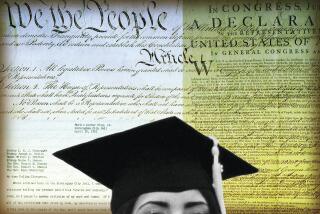New Curriculum Aims to Bring History, Social Studies to Life
SACRAMENTO — Fifth-graders at Weibel Elementary School in the East San Francisco Bay community of Fremont were simulating 19th-Century fur trading as part of their study of America’s westward expansion.
Groups of youngsters “sold” pelts to fellow student Jason Sharma, playing the role of a St. Louis merchant, then used the proceeds to “buy” provisions for spending the winter in the mountains.
“This ties history to economics, politics and geography,” teacher Diane Duey said. “The kids enjoy it much more than reading something out of a book and then answering questions at the end of the chapter.”
This hands-on exercise was part of a pilot project to test a new California curriculum that aims to breathe life back into the moribund study of history and social studies.
The new curriculum calls for much more instruction than before--three years of U.S. history and three of world history between the sixth and 12th grades. There is a renewed emphasis on geography, a subject recent national studies show high school seniors know little about.
The history of religion, usually avoided as too controversial, is included at all grade levels. And there is a lot of discussion about democracy--how difficult it has been to achieve and then maintain, whether in the United States 200 years ago or in Eastern Europe today.
Although the curriculum has been tested in only a few school districts and won’t be in widespread use for another year or two, it has already been praised by some educators and professional historians.
“The California curriculum is an improvement in every way,” said Gilbert T. Sewall, director of the American Textbook Council, which seeks to improve the quality of social studies textbooks. “It is history and geography-centered, it is multicultural and it stresses the use of primary sources.”
But others see problems with the new approach.
They wonder if there are enough expert teachers to handle the new courses and if the available textbooks and other instructional materials are adequate. Some critics say the approach is too conservative, others think it too liberal, while others dislike how religion is handled.
California’s plan is to bolster the curriculum, train better history and social studies teachers and make classes more interesting.
In the early grades, children will read stories, poems, biographies and other literature about historical figures.
“We looked at the current research on how children learn, and we found that the best literature of the period is a wonderful way to get children interested in the history of the period,” said Diane L. Brooks, manager of the history-social science unit in the State Department of Education.
In grades six, seven and 10, students will get a full year of world history. They will get a full year of U.S. history in grades five, eight and 11.
“This means they will be getting much more history than now,” Brooks said, “more, we think, than in any other state.”
In an important change, the 11th-grade U.S. history course will deal only with the 20th Century, leaving everything before that to be taught in the fifth and eighth grades, plus a six-week review at the beginning of the 11th grade.
Jerrell Croskrey, an 11th-grade history teacher at Lincoln High School in Stockton, likes the change.
“Before, it was always a race to get from 1492 to the present day,” Croskrey said. “Now, we can stop to examine an issue or an event for a day or two.”
Some historians worry, however, that many students will enter the 11th grade with little or no knowledge of American history--either because they are newly arrived in California or because they have forgotten what they were taught in earlier grades.
“What we’re saying is, it’s perfectly all right for students beyond the age of 12 not to get any U.S. history except 20th-Century,” said Leon F. Litwack, a Pulitzer Prize-winning professor of American history at UC Berkeley. “I don’t find that a very acceptable approach.”
But Diane Ravitch, professor of history at Columbia University’s Teachers’ College and a principal designer of the new curriculum, called the approach better than traditional “soup-to-nuts” survey courses.
The approach ideas were adopted by the State Board of Education three years ago.
Its principal authors were Ravitch and Charlotte Crabtree, professor of education at UCLA. They received vigorous support from state Supt. of Public Instruction Bill Honig, who has argued for a stronger history curriculum since his election in 1982.
The new curriculum makes heavy demands on teachers.
In the elementary grades, teachers are urged to seek out original historical materials, in libraries or on college campuses, and bring them to the classroom.
Daniel Chernow, a member of the state Curriculum Commission, said the new history and social studies courses should begin with or without an adequate number of expert teachers.
There are also important questions about the quality of textbooks and other materials.
Only one major publisher--Houghton Mifflin--submitted a complete kindergarten-to-eighth-grade series based on the new curriculum. Nine publishers submitted a total of 26 books.
After studying the materials for three months, panels appointed by the state Curriculum Commission concluded that only 10 books--the kindergarten to eighth-grade series published by Houghton Mifflin and the Holt, Rinehart & Winston eighth-grade book--were acceptable.
At a commission hearing in Sacramento earlier this month, the Houghton Mifflin series came under attack from groups representing Jews, Muslims, Fundamentalist Christians, gays, lesbians and others.
Those who disagree will get one more chance to voice their protests at a public hearing the Board of Education will hold in September.
More to Read
Sign up for Essential California
The most important California stories and recommendations in your inbox every morning.
You may occasionally receive promotional content from the Los Angeles Times.









